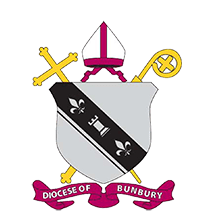On 25th January 1846, three missions for the natives were decided upon. One was to be in the north at Port Essington (Darwin), one in the centre in the Victoria Plains area (New Norcia) and one in the south at King George Sound. The French missionaries for the south were first to leave on 6th February 1846 accompanied by the Bishop’s Pro-Vicar, Fr Powell, who had joined the group from Ireland. At Albany they were received by Fr Joostens and settled in a house Fr Powell hired for them.
On 1st March, Fr Powell returned to Perth leaving the missionaries with very scant means of subsistence and orders that they attend to the natives only and to go into the interior. Despite various excursions, which took them as far as Kojonup, there were practically no natives to be found and only in very small groups.
Bishop Brady appears to have been antagonistic towards the missionaries, not understanding their plight at all and considering they were too tardy in establishing their mission. Accordingly on 24th June, Fr Powell was sent back to Albany with new instructions for them to depart for the interior despite having no food, nor money, and a gravely ill Fr Thierse. Fr Powell arranged for the missionaries to receive some supplies from one of the settlers. He then accompanied Fr Thevaux on an excursion to Lake Mollyalup before returning to Perth a few days later.
The missionaries’ fortunes improved when a whaler which had suffered great troubles at sea, put into Albany and the Captain, M. Coubriere, supplied them with some money. With renewed hope and a few supplies, Fr Thevaux and Br Vincent set out on 10th October to establish Lake Mollyalup, leaving Fr Thierse at the Sound. Two weeks were spent clearing, felling and splitting trees with which to build their mission before returning to the Sound where the decision was made that Fr Thierse should go there to live permanently. The building which Fr Thevaux describes as “consisting of a chapel, two small rooms, a kitchen with an alcove in it for Br Vincent and a community room which is the kitchen itself” was finished after a further 15 days work and solemnly blessed on the Feast of the Nativity, naming it Sancta Maria. A week later, Frs Thevaux and Thierse again returned to the Sound, this time to make arrangements for a final move to Sancta Maria.
With no help from the Bishop, virtually nothing live on and their credit stopped by every supplier, Fr Thevaux decided to send Fr Thierse back to Mollyalup with a few biscuits and some salted fish to sustain the unfortunate Br Vincent, intending to accompany him halfway himself as Fr Thierse was too weak to carry the bundle. He had only gone a short way when he developed a severe foot pain and had to turn back to Albany taking nine hours to cover six miles. By the end of January, Fr Thevaux had eaten all his bread and lived for many days on a few potatoes, but at Sancta Maria, the position was even worse, as Fr Thierse lived on a plague of frogs which appeared miraculously and were easily caught in the grass and just as amazingly disappeared when he received a supply of bread.
In 14th March 1847, Fr Thevaux arrived in Perth to report on the state of the mission to Bishop Brady. The result was an unfortunate scene in which Bishop Brady harangued Fr Thevaux and finally suspended him, but everyone present at the meeting was overawed by the humility and saintliness of the French priest. He returned to Albany where he tried to cash a bill for sixteen pounds from Captain Hassell, but the Captain had been instructed by the Bishop not to give him a penny.
Fr Thevaux arrived back at Sancta Maria in time for Easter and the Easter retreat during which time Fr Thierse fell very sick, due to the physical and mental strain he had endured. Finally on l6th June 1847, the three missionaries left the solitude and privations of Lake Mollyalup for the last time, taking only a few personal possessions and the bare essentials for their journey, leaving the rest to providence.
The journey to Albany was again one of unbelievable hardship. Although they walked for three days in water, often up to their shoulders, spending the nights in the open in torrential rain and strong winds, Fr Thierse reported that “the good God in a marvellous manner provided a fire for us when we were almost humbled with the cold and the wet”.
The story of Sancta Maria appeared to have ended when the three missionaries embarked on 16th July on the “Eudora” for Mauritius, but it did not end so easily. Twice the “Eudora” was forced back to port by storms and by the time it made its third departure Fr Thierse was so ill he had to be left behind. It was to be a further twelve months before he eventually left King George Sound.
From his writings it would appear that his final 12 months was the most fruitful period of his mission and a lot was accomplished. It appears that as his strength returned, he made longer and longer trips back into the country and in Albany instructed many natives.
It would seem that at times he visited Lake Mollyalup and probably spent Christmas of 1847 there, exactly a year after it had been blessed, but he never lived there permanently again. Finally, Fr Thierse sailed from Albany on the “Arpentour” arriving at Port Louis in September 1848.
The above story of Sancta Maria is a précis of an article written by Fr J. McCarthy, together with a chronological account of the church in Albany compiled by Fr N. FitzSimons for the centenary of the Catholic Church in Albany in
